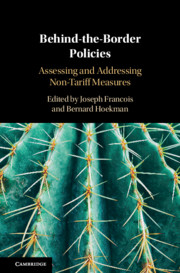Book contents
- Behind-the-Border Policies
- Behind-the-Border Policies
- Copyright page
- Contents
- Figures
- Tables
- Boxes
- Contributors
- 1 Moving beyond the Border
- Part I Concepts and Measurement
- Part II Assessing and Benchmarking Policy
- 4 Non-tariff Measures in the Presence of Global Value Chains and Their Impact on Productivity
- 5 Non-tariff Measure Estimations in Different Impact Assessments
- 6 Gauging Procurement Policy Change during the Crisis Era
- 7 Preferences, Income Distribution, and the Burden of Non-tariff Measures
- Part III Dealing with Non-tariff Measures: Legal and Institutional Contexts
- References
- Index
7 - Preferences, Income Distribution, and the Burden of Non-tariff Measures
from Part II - Assessing and Benchmarking Policy
Published online by Cambridge University Press: 25 October 2019
- Behind-the-Border Policies
- Behind-the-Border Policies
- Copyright page
- Contents
- Figures
- Tables
- Boxes
- Contributors
- 1 Moving beyond the Border
- Part I Concepts and Measurement
- Part II Assessing and Benchmarking Policy
- 4 Non-tariff Measures in the Presence of Global Value Chains and Their Impact on Productivity
- 5 Non-tariff Measure Estimations in Different Impact Assessments
- 6 Gauging Procurement Policy Change during the Crisis Era
- 7 Preferences, Income Distribution, and the Burden of Non-tariff Measures
- Part III Dealing with Non-tariff Measures: Legal and Institutional Contexts
- References
- Index
Summary
The link between trade and inequality has been of central importance in analysing international trade since the seminal work of Stolper and Samuelson (1941). While early work on the topic was primarily theoretic, with improved data availability more recent contributions have examined it empirically, with examples using aggregate data including Bergh and Nilsson (2010) and those with micro data including Cosar, Guner, and Tybout (2016). Some studies, such as Jaumotte, Lall, and Papageorgiou (2013), find that the inequality impact of trade is secondary when compared to factors such as technological change while others such as Lim and McNelis (2014) find that the impact is conditional on other factors. In any case, the evidence consistently points to a significant potential for increased trade to exacerbate inequality. More recent contributions, however, discuss the role in inequality itself in determining trade when preferences are non-homothetic. In particular, a growing literature has replaced homothetic preferences with Stone-Geary preferences. Examples include Francois and Kaplan (1996), Bekkers, Francois, and Manchin (2012), Markusen (2013), Caron, Fally, and Markusen (2014), and Bertoletti and Etro (2016). In particular, Bekkers et al. (2012) find evidence in the data on prices of tradeables and inequality that is consistent with the hierarchical demand patterns predicted by the Stone-Geary approach to incorporating non-homothetic preferences in a trade model. Within these models, the key is that the consumption of certain goods (luxuries) only begins when a given consumer reaches a minimum income level. The empirical work also finds that income distribution within a country can be a driving force in trade patterns (e.g. Francois and Kaplan, 1996; Hummels and Klenow, 2005; Dalgin, Trindade, and Mitra, 2008; Fieler, 2011; and Tasarov, 2012).
Information
- Type
- Chapter
- Information
- Behind-the-Border PoliciesAssessing and Addressing Non-Tariff Measures, pp. 150 - 176Publisher: Cambridge University PressPrint publication year: 2019
